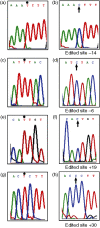Altered editing in RNA editing adenosine deaminase ADAR2 gene transcripts of systemic lupus erythematosus T lymphocytes
- PMID: 17376196
- PMCID: PMC2265949
- DOI: 10.1111/j.1365-2567.2007.02582.x
Altered editing in RNA editing adenosine deaminase ADAR2 gene transcripts of systemic lupus erythematosus T lymphocytes
Abstract
Adenosine Deaminases that act on RNA (ADARs) edit gene transcripts through site-specific conversion of adenosine to inosine by hydrolytic deamination at C6 of the adenosine. ADAR2 gene transcripts are substrates for the ADAR1 and ADAR2 enzymes and their expression is regulated by editing at the - 1 and - 2 sites. Our previous experiments demonstrated up-regulation of type I interferon (IFN) inducible 150 kDa ADAR1 in systemic lupus erythematosus (SLE) T cells. In this study we investigate the role of ADAR1 and ADAR2 in editing of ADAR2 gene transcripts of healthy controls and SLE patients. The ADAR2 gene transcripts were cloned into pCR2.1-TOPO vectors. A total of 150 clones from SLE and 150 clones from controls were sequenced. Sequence analysis demonstrated A to I editing at - 1, + 10, + 23 and + 24 in normal T cells. In SLE clones site-selective editing of the - 2 site was observed as a result of type I IFN-inducible 150 kDa ADAR1 expression. These results are confirmed by analysing ADAR2 transcripts of normal T cells activated with type I IFN-alpha. Editing of the + 23 and + 24 sites was decreased in SLE T cells compared to normal controls. In addition to A to G changes, U to C discrepancies were observed in normal and SLE T cells. In SLE cells, positions - 6 and + 30 were frequently edited from U to C compared to normal controls. Taken together, these results demonstrate altered and site-selective editing in ADAR2 transcripts of SLE patients. Based on these results, it is proposed that altered transcript editing contributes to the modulation of gene expression and immune functions in SLE patients.
Figures







Similar articles
-
Altered editing in cyclic nucleotide phosphodiesterase 8A1 gene transcripts of systemic lupus erythematosus T lymphocytes.Immunology. 2008 Nov;125(3):408-19. doi: 10.1111/j.1365-2567.2008.02850.x. Epub 2008 May 6. Immunology. 2008. PMID: 18462347 Free PMC article.
-
Induction of 150-kDa adenosine deaminase that acts on RNA (ADAR)-1 gene expression in normal T lymphocytes by anti-CD3-epsilon and anti-CD28.Immunology. 2007 Dec;122(4):623-33. doi: 10.1111/j.1365-2567.2007.02709.x. Epub 2007 Sep 25. Immunology. 2007. PMID: 17897325 Free PMC article.
-
Transcript mutations of the alpha regulatory subunit of protein kinase A and up-regulation of the RNA-editing gene transcript in lupus T lymphocytes.Lancet. 2002 Sep 14;360(9336):842-9. doi: 10.1016/s0140-6736(02)09966-x. Lancet. 2002. PMID: 12243919
-
Editing of messenger RNA precursors and of tRNAs by adenosine to inosine conversion.FEBS Lett. 1999 Jun 4;452(1-2):71-6. doi: 10.1016/s0014-5793(99)00590-6. FEBS Lett. 1999. PMID: 10376681 Review.
-
ADAR RNA editing in human disease; more to it than meets the I.Hum Genet. 2017 Sep;136(9):1265-1278. doi: 10.1007/s00439-017-1837-0. Epub 2017 Sep 14. Hum Genet. 2017. PMID: 28913566 Review.
Cited by
-
Consistent levels of A-to-I RNA editing across individuals in coding sequences and non-conserved Alu repeats.BMC Genomics. 2010 Oct 28;11:608. doi: 10.1186/1471-2164-11-608. BMC Genomics. 2010. PMID: 21029430 Free PMC article.
-
Elevated signal transducers and activators of transcription 1 correlates with increased C-C motif chemokine ligand 2 and C-X-C motif chemokine 10 levels in peripheral blood of patients with systemic lupus erythematosus.Arthritis Res Ther. 2014 Jan 23;16(1):R20. doi: 10.1186/ar4448. Arthritis Res Ther. 2014. PMID: 24451065 Free PMC article.
-
Is Tolerance Broken in Autoimmunity?Clin Med Insights Pathol. 2017 May 16;10:1179555717712716. doi: 10.1177/1179555717712716. eCollection 2017. Clin Med Insights Pathol. 2017. PMID: 28579863 Free PMC article.
-
Increased RNA Editing May Provide a Source for Autoantigens in Systemic Lupus Erythematosus.Cell Rep. 2018 Apr 3;23(1):50-57. doi: 10.1016/j.celrep.2018.03.036. Cell Rep. 2018. PMID: 29617672 Free PMC article.
-
Increased adenosine-to-inosine RNA editing in rheumatoid arthritis.J Autoimmun. 2020 Jan;106:102329. doi: 10.1016/j.jaut.2019.102329. Epub 2019 Sep 5. J Autoimmun. 2020. PMID: 31493964 Free PMC article.
References
Publication types
MeSH terms
Substances
Grants and funding
LinkOut - more resources
Full Text Sources
Medical
Research Materials

